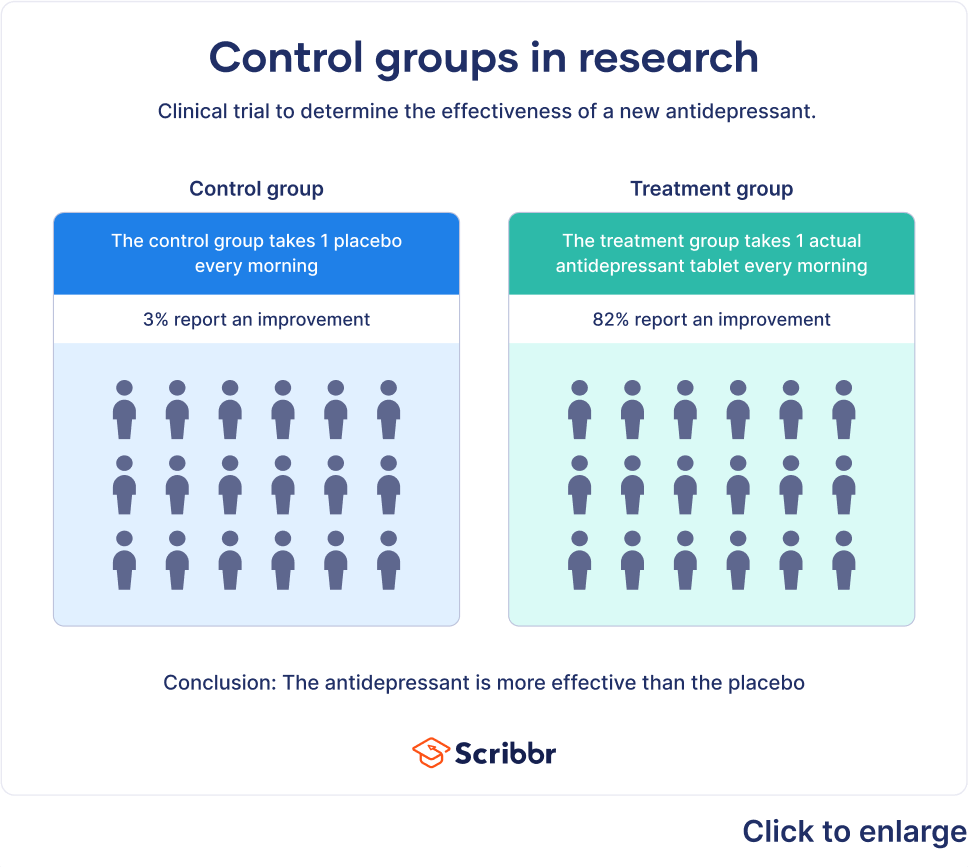Control Groups & Treatment Groups | Uses & Examples
In a scientific study, a control group is used to establish a cause-and-effect relationship by isolating the effect of an independent variable.
Researchers change the independent variable in the treatment group and keep it constant in the control group. Then they compare the results of these groups.
Using a control group means that any change in the dependent variable can be attributed to the independent variable.
Control groups in experiments
Control groups are essential to experimental design. When researchers are interested in the impact of a new treatment, they randomly divide their study participants into at least two groups:
- The treatment group (also called the experimental group) receives the treatment whose effect the researcher is interested in.
- The control group receives either no treatment, a standard treatment whose effect is already known, or a placebo (a fake treatment).
The treatment is any independent variable manipulated by the experimenters, and its exact form depends on the type of research being performed. In a medical trial, it might be a new drug or therapy. In public policy studies, it could be a new social policy that some receive and not others.
In a well-designed experiment, all variables apart from the treatment should be kept constant between the two groups. This means researchers can correctly measure the entire effect of the treatment without interference from confounding variables.
- You pay the students in the treatment group for achieving high grades.
- Students in the control group do not receive any money.
By comparing the average change in their grades over the year, you can find out whether monetary incentives improve school performance.
Studies can also include more than one treatment or control group. Researchers might want to examine the impact of multiple treatments at once, or compare a new treatment to several alternatives currently available.
- The treatment group gets the new pill.
- Control group 1 gets an identical-looking sugar pill (a placebo).
- Control group 2 gets a pill already approved to treat high blood pressure.
Since the only variable that differs between the three groups is the type of pill, any differences in average blood pressure between the three groups can be credited to the type of pill they received.
- The difference between the treatment group and control group 1 demonstrates the effectiveness of the pill as compared to no treatment.
- The difference between the treatment group and control group 2 shows whether the new pill improves on treatments already available on the market.
Control groups in non-experimental research
Although control groups are more common in experimental research, they can be used in other types of research too. Researchers generally rely on non-experimental control groups in two cases: quasi-experimental or matching design.
Control groups in quasi-experimental design
While true experiments rely on random assignment to the treatment or control groups, quasi-experimental design uses some criterion other than randomisation to assign people.
Often, these assignments are not controlled by researchers, but are pre-existing groups that have received different treatments. For example, researchers could study the effects of a new teaching method that was applied in some classes in a school but not others, or study the impact of a new policy that is implemented in one region but not in the neighbouring region.
In these cases, the classes that did not use the new teaching method, or the region that did not implement the new policy, is the control group.
Control groups in matching design
In correlational research, matching represents a potential alternate option when you cannot use either true or quasi-experimental designs.
In matching designs, the researcher matches individuals who received the ‘treatment’, or independent variable under study, to others who did not – the control group.
Each member of the treatment group thus has a counterpart in the control group identical in every way possible outside of the treatment. This ensures that the treatment is the only source of potential differences in outcomes between the two groups.
Instead, you can create a control group by matching individuals who do not smoke with those who do (the treatment group) on age, gender, diet, level of exercise, and so on, ensuring that the only difference between the two groups – and thus the only variable that could cause differences in their rates of lung cancer – is their use of e-cigarettes.
Importance of control groups
Control groups help ensure the internal validity of your research. You might see a difference over time in your dependent variable in your treatment group. However, without a control group, it is difficult to know whether the change has arisen from the treatment. It is possible that the change is due to some other variables.
If you use a control group that is identical in every other way to the treatment group, you know that the treatment – the only difference between the two groups – must be what has caused the change.
For example, people often recover from illnesses or injuries over time regardless of whether they’ve received effective treatment or not. Thus, without a control group, it’s difficult to determine whether improvements in medical conditions come from a treatment or just the natural progression of time.
Risks from invalid control groups
If your control group differs from the treatment group in ways that you haven’t accounted for, your results may reflect the interference of confounding variables instead of your independent variable.
Since those who come from a family of smokers are more likely to be exposed to secondhand smoke, a known cause of cancer, higher rates may occur among individuals in your treatment group, but you can’t know for sure if this difference is due to the use of e-cigarettes.
Minimising this risk
A few methods can aid you in minimising the risk from invalid control groups.
- Ensure that all potential confounding variables are accounted for, preferably through an experimental design if possible, since it is difficult to control for all the possible confounders outside of an experimental environment.
- Use double-blinding. This will prevent the members of each group from modifying their behavior based on whether they were placed in the treatment or control group, which could then lead to biased outcomes.
- Randomly assign your subjects into control and treatment groups. This method will allow you to not only minimise the differences between the two groups on confounding variables that you can directly observe, but also those you cannot.
Frequently asked questions about control groups
Cite this Scribbr article
If you want to cite this source, you can copy and paste the citation or click the ‘Cite this Scribbr article’ button to automatically add the citation to our free Reference Generator.
Thomas, L. (2023, April 13). Control Groups & Treatment Groups | Uses & Examples. Scribbr. Retrieved 2 July 2025, from https://www.scribbr.co.uk/research-methods/control-groups/

